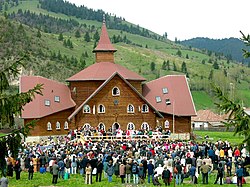Lunca de Sus
|
Lunca de Sus Gyimesfelsőlok |
||
|---|---|---|
| Commune | ||

St. Elisabeth of Hungary School, 'The House built on the Rock'
|
||
|
||
 |
||
| Coordinates: 46°32′0″N 25°58′0″E / 46.53333°N 25.96667°ECoordinates: 46°32′0″N 25°58′0″E / 46.53333°N 25.96667°E | ||
| Country |
|
|
| County | Harghita County | |
| Status | Commune | |
| Government | ||
| • Mayor | Timár Zsombor-László (Democratic Union of Hungarians in Romania) | |
| Area | ||
| • Total | 82.6 km2 (31.9 sq mi) | |
| Population (2011) | ||
| • Total | 3,242 | |
| Ethnicity | ||
| • Hungarians | 97.1% | |
| • Romanians | 1.05% | |
| Time zone | EET (UTC+2) | |
| • Summer (DST) | EEST (UTC+3) | |
| Postal Code | 537155 | |
| Area code(s) | +40 266 | |
| Website | http://www.gyimesfelsolok.ro | |
Lunca de Sus (Hungarian: Gyimesfelsőlok; Hungarian pronunciation: [ˈɟimɛʃfɛlʃøːlok] or colloquially Felsőlok) is a commune in Harghita County, Romania. It lies in the Szekely Land, an ethno-cultural region in eastern Transylvania.
The commune is composed of six villages:
Izvorul Trotușului also includes Ciherek-pataka, Bothavas-pataka and Farkas-pataka, while the Lunca de Sus village also includes Nyíresalja and Libaváros ("Goose-city").
The settlement came into being out of the outer areas of Szépvíz and Csíkszentmihály villages, but became a separate village only as late as around 1850.
The village is situated near the old Hungarian border, and therefore protection had to be provided. The Tartar invasions through the valley left many victims behind. In the end, in 1701-1702, the construction of a moat was commenced on Csapó-hill next to the village. The traces of the earthworks can still be seen these days at a length of 120–150 meters.
According to the tradition, the first family that settled into the valley was the Tankó-family.
The village administratively belonged to Csíkszék, then, from 1876 until 1918 to the Csík County in the Kingdom of Hungary. After World War I, by the terms of the Treaty of Trianon of 1920, it became part of Romania. As a result of the Second Vienna Award, it belonged to Hungary again between 1940 and 1944. After World War II, it came under Romanian administration and became part of Romania in 1947. Between 1952 and 1960, it formed part of the Magyar Autonomous Region, then, of the Mureș-Hungarian Autonomous Province until it was abolished in 1968. Since then, the commune has been part of Harghita County.
...
Wikipedia


